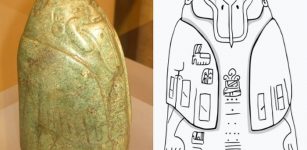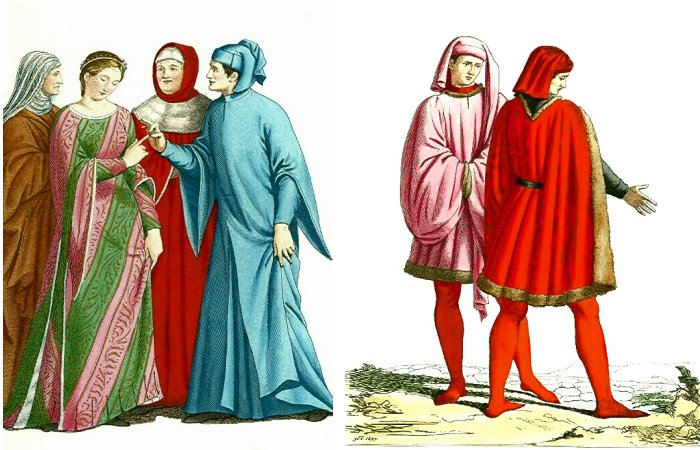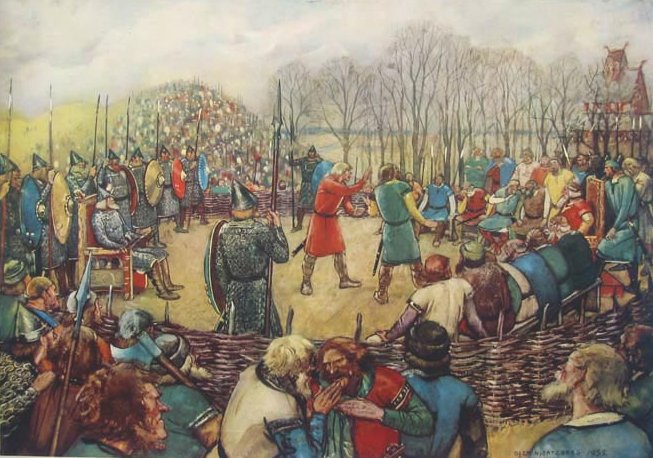Why Were Medieval People Easily Offended And Scared Of Rumors?
Ellen Lloyd - AncientPages.com - Anyone can be offended by anything at any time today. We see this almost every day, especially on social media, but looking through the eyes of modern society, one can say that Medieval people were extremely easily offended and were very scared of rumors. History shows this behavior can be explained, and there are valid reasons why insults could not be tolerated during the Middle Ages.
During the Middle Ages, honor and courage were highly significant, and injustice could have fatal consequences. Medieval knights followed chivalry - the lifestyle and moral code based on values such as honor, bravery, courteousness, and honesty.
The medieval tradition of chivalry did not survive because of the political situation in Europe following the Renaissance. Credit: Public Domain
Insults could lead to death. In some countries like Iceland and Ireland, it was common to humiliate others by performing satirical songs. “The most effective, these songs were to be performed not only in public but also in the presence of the intended victim.
The effects of such open insults were terrible and lasting, and little remained for the victim other than revenge or death. The most heinous of all accusations were the ergi (sing., argr or ragr), which included not only such acts as homosexuality, pederasty, and sodomy, but also such crimes as cowardice in battle, treason, heresy, perjury, and murder. In Iceland, as in Ireland, the task of performing public ridicule was entrusted to the professional singer-poets, the Skalds.” 1
You Could Be Convicted Based On Rumors
According to Ole-Albert Rønning Nordby from the University of Oslo in Norway, many Medieval deaths were caused by rumors. Rumors and accusations could have fatal consequences for the victim. Nordby explained that rumors during the Middle Ages had the same weight as evidence today. If there was a rumor that a man had been unfaithful, and he could not prove this accusation false, he could be punished. Basically, rumors could start an investigation, and an uncertain or doubtful truth could get convicted.
The practice of law and justice in the Middle Ages was different from our modern system. If you were accused, you had to face a trial and swear an oath, but the sworn oath had a different weight than today.
Left: Illustration of Renaissance clothing by Paul Mercuri from "Costumes Historiques" (Paris, ca.1850′s or 60’s). Credit: Public Domain - Right: Illustration of Renaissance clothing by Paul Mercuri from "Costumes Historiques" (Paris, ca.1850′s or 60’s). Credit: Public Domain
Nordby, who studied how justice in Scandinavia worked during the Middle Ages, focusing on the importance of sworn oaths for the judicial process, explained the system was completely different from what we are accustomed to today.
During the Middle Ages, it was not enough that you placed your hand on the Bible and swore to tell the truth and nothing but the truth. You could swear you were innocent, but this was by no means enough. You also had to have witnesses who could attest that you were not the kind of person who could commit this particular type of crime. In other words, you needed character witnesses. In the case of infidelity, two additional persons besides yourself must certify that you have not been unfaithful. If they testified in your favor, then the case was closed, and you were declared innocent.
A False Testimony Was Dangerous
Going to court and giving a false testimony was very dangerous and the worst thing a person could do. Nordby explained it was much better to admit the truth than to lie. A person who lied lost the right to defend himself and risked being outlawed.
A witness who was called to testify could never be of lower social status than the accused. A newly released slave, for example, could not testify against or for his former master. Nordby suggests this prevented the rich from bribing the poor to testify in their favor.
In those days, judges could not rely on technical evidence, but it’s interesting to note that eyewitnesses had a much higher Medieval court value than a sworn oath. Nordby’s research also revealed that the burden of proof during the Middle Ages lay on the accused, not the prosecutor as it is today.
There were many differences, and proving your innocence could be extremely difficult in many cases. It could also take a long time before you received your verdict.
Some aspects of the Medieval judiciary remind us of the Viking Thing system. The Thing was the governing assembly made up of the free people of the community. Each community had its own independent Thing where all free Vikings could gather to make law, resolve disputes, and make decisions. The meeting place was called a thingstead.
The Thing met at specific, regular times and meetings could sometimes last for several days. Each Thing had a law speaker who would recite the law from memory. Illustration by Hjortzberg, O. 1932 - Norstedt und Söner/Westermann/Esselte/Stockmann, P., Stockholm - Public Domain
In Viking society, people sometimes decided to solve a matter through a challenge. This was done by a Holmgang, a duel that had to take place within three to seven days after the challenge was announced.
The Thing system was considered better than having disputes settled by duel or family feuds.
Those who faced a trial at the Thing knew the verdict could devastate their lives. People who were found guilty were either fined, declared semi-outlaw, or fully outlawed. To be an outlaw was a dreadful punishment for a Viking, as it resulted in being banished from society and having one's property confiscated.
Updated on October 1, 2023
Written by Ellen Lloyd – AncientPages.com
Copyright © AncientPages.com All rights reserved. This material may not be published, broadcast, rewritten or redistributed in whole or part without the express written permission of AncientPages.com
Expand for references- Ward, Donald. "Honor and Shame in the Middle Ages: An Open Letter to Lutz Röhrich." Jahrbuch Für Volksliedforschung27/28 (1982): 1-16. doi:10.2307/848480.
- Aftonbladet
- George Burton Adams - Civilization During the Middle Ages
- Freeman, Henry - The Middle Ages: A History From Beginning to End
More From Ancient Pages
-
 Face Of Iron Age Female Druid Reconstructed
Archaeology | Aug 20, 2019
Face Of Iron Age Female Druid Reconstructed
Archaeology | Aug 20, 2019 -
 On This Day In History: Agatha Christie Known As ‘Queen Of Crime’ Died – On Jan 12, 1976
News | Jan 12, 2017
On This Day In History: Agatha Christie Known As ‘Queen Of Crime’ Died – On Jan 12, 1976
News | Jan 12, 2017 -
 On This Day In History: Battle Of Vincennes, Indiana – On Feb 24-25, 1779
News | Feb 24, 2017
On This Day In History: Battle Of Vincennes, Indiana – On Feb 24-25, 1779
News | Feb 24, 2017 -
 X-Rays Reveal Secret From Da Vinci’s Masterpiece Mona Lisa
News | Oct 14, 2023
X-Rays Reveal Secret From Da Vinci’s Masterpiece Mona Lisa
News | Oct 14, 2023 -
 1,000-Year-Old Palace Kitchen With A Cannonball Inside An Oven Found At Harput Castle In Elazig, Turkey
Archaeology | Aug 28, 2023
1,000-Year-Old Palace Kitchen With A Cannonball Inside An Oven Found At Harput Castle In Elazig, Turkey
Archaeology | Aug 28, 2023 -
 Strange Tuxtla Statuette And Its Undeciphered Inscription – An Epi-Olmec Puzzle
Artifacts | Mar 14, 2018
Strange Tuxtla Statuette And Its Undeciphered Inscription – An Epi-Olmec Puzzle
Artifacts | Mar 14, 2018 -
 ‘Sea Monsters’ Were Real Millions Of Years Ago: New Fossils Tell About Their Rise And Fall
Featured Stories | Oct 8, 2022
‘Sea Monsters’ Were Real Millions Of Years Ago: New Fossils Tell About Their Rise And Fall
Featured Stories | Oct 8, 2022 -
 2,000-Year-Old Factory Producing Roman Fish Sauce Unearthed In Ashkelon, Israel
Archaeology | Jan 7, 2020
2,000-Year-Old Factory Producing Roman Fish Sauce Unearthed In Ashkelon, Israel
Archaeology | Jan 7, 2020 -
 Seven Gods Of Happiness – Bring Luck, Prosperity And Health In Japanese Folk Belief
Featured Stories | Jun 29, 2020
Seven Gods Of Happiness – Bring Luck, Prosperity And Health In Japanese Folk Belief
Featured Stories | Jun 29, 2020 -
 ‘Masters Of The Desert’ – Hohokam People, Massive Caliche Structures And Sophisticated Extensive Irrigation Canals
Civilizations | May 31, 2016
‘Masters Of The Desert’ – Hohokam People, Massive Caliche Structures And Sophisticated Extensive Irrigation Canals
Civilizations | May 31, 2016 -
 First Cemetery Dated To Roman Period Discovered In North Saqqara, Egypt
Archaeology | Nov 12, 2019
First Cemetery Dated To Roman Period Discovered In North Saqqara, Egypt
Archaeology | Nov 12, 2019 -
 On This Day In History: Battle Of Naulochus Was Fought Off The Coast Of Sicily – On Sep 3, 36 BC
News | Sep 3, 2015
On This Day In History: Battle Of Naulochus Was Fought Off The Coast Of Sicily – On Sep 3, 36 BC
News | Sep 3, 2015 -
 Mysterious Ancient Site Of Çatalhöyük: Remains Of Early Structures May Shed More Light On Its Obscure Past
Archaeology | Apr 11, 2017
Mysterious Ancient Site Of Çatalhöyük: Remains Of Early Structures May Shed More Light On Its Obscure Past
Archaeology | Apr 11, 2017 -
 Fragments Of 50-Mile-Long Roman Aqueduct And Road In Cádiz, Spain Revealed By Storm
Archaeology | Mar 10, 2018
Fragments Of 50-Mile-Long Roman Aqueduct And Road In Cádiz, Spain Revealed By Storm
Archaeology | Mar 10, 2018 -
 Goibniu: The Sword Smith Of Tuatha De Danann Who Forged Weapons For Battles In Celtic Mythology
Celtic Mythology | Jan 31, 2020
Goibniu: The Sword Smith Of Tuatha De Danann Who Forged Weapons For Battles In Celtic Mythology
Celtic Mythology | Jan 31, 2020 -
 Sutton Hoo Ship Burial And Famous Helmet That Could Belong To Raedwald, King Of All The Kings Of Britain
Artifacts | Jan 9, 2018
Sutton Hoo Ship Burial And Famous Helmet That Could Belong To Raedwald, King Of All The Kings Of Britain
Artifacts | Jan 9, 2018 -
 Is A Time Travel Machine Based On Secret Ancient Egyptian Knowledge Hidden In London?
Ancient Mysteries | Oct 20, 2017
Is A Time Travel Machine Based On Secret Ancient Egyptian Knowledge Hidden In London?
Ancient Mysteries | Oct 20, 2017 -
 Lofn ‘Matchmaker’ – Norse Goddess Of Forbidden Marriages Of People Who Wish To Be Loved And Search For Partners
Featured Stories | Mar 25, 2021
Lofn ‘Matchmaker’ – Norse Goddess Of Forbidden Marriages Of People Who Wish To Be Loved And Search For Partners
Featured Stories | Mar 25, 2021 -
 Ancient People In Peru Had A Unique Response To The Looting And Destruction Of Their Ancestors’ Graves
Archaeology | Feb 3, 2022
Ancient People In Peru Had A Unique Response To The Looting And Destruction Of Their Ancestors’ Graves
Archaeology | Feb 3, 2022 -
 The Aztec Sun Stone And Medusa Reveal An Intriguing Connection – Surprising Discovery – Part 1
Ancient Mysteries | Jul 30, 2018
The Aztec Sun Stone And Medusa Reveal An Intriguing Connection – Surprising Discovery – Part 1
Ancient Mysteries | Jul 30, 2018



